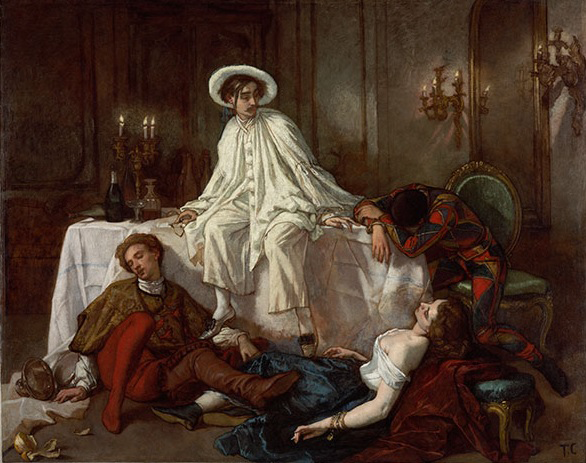By Jimena Martinez Gerhard
While our society is interested in speed, Jennifer L. Roberts, the Elizabeth Cary Agassiz Professor of the Humanities at Harvard University, advocates for a better way to approach art. Her “slow looking “technique is no more than what is sounds. It is simply standing in front of a painting and letting yourself be immersed in it while the formal qualities unfold before your eyes. Looking is the best tool to understand a piece of art, as I have experienced with Thomas Couture’s painting Supper at the Maison d’Or (Each Party has an Ending) (1885) presented at the National Gallery of Canada.

Thomas Couture, Supper at the Maison d’Or also known as Each Party has its Ending, 1855, oil on canvas, 180.0 x 228.0 cm, Collection of the Vancouver Art Gallery, Presented by Mr. and Mrs. Jonathan Rogers, VAG 31.101, Photo © NGC.
Supper at the Maison d’Or depicts the end of social gathering with four guests resting after a long night of celebration. When we first encounter a work of art, our eyes are trained to first look for the formal qualities such as colour, line and perspective. The oil painting has a luminous, painterly texture with unsaturated gray and brown hues contrasting with vivid warm and white colours. Shadows and highlights are achieved by free and rapid brushstrokes of pure red, white, yellow and brown. However, a second sight can reveal more than you can think.
After spending two hours looking at Couture’s painting, my first impressions begin to transform into more meaningful readings of the artwork. At first, the central figures seem to have a status of wealth due to the presence of fancy objects in the setting. But the brown and blue colours slowly start to give the impression of rusty copper, the objects lose their lavish quality and the impeccable shiny and white tablecloth becomes wrinkled with dark stains. The setting ceases to belong to the high class.
At the apex of the triangular composition, the man in white is the most compelling figure in Supper at the Maison d’Or. The rusty copper colour surrounding him begins to intensify. It appears in his shadow, his wrinkled clothing and the outlines of his exhausted face. The intensity of Couture’s application of copper paint begins to appear like filth on the man’s face and clothing. His white clothing no longer suits him; it begins to seem large, untailored to his figure and of lesser quality like old brown silk. The man’s efforts to try to place himself in a higher social class become apparent after looking with careful attention. Even his head, framed by a white hat, resembles a crown that demonstrates the man’s desire to fit into a higher status.
Couture’s Supper at the Maison d’Or communicates ideas of social class with allusions to wealth that go beyond the first impression. By looking closely, slowly, it reveals the natural wish to belong to something above us. There is always more than what meets the eye. A painting can deceive or not give enough meaning at first sight, but if you just stop and look you will find more than what you expected.
Editor’s Note: Thomas Couture’s Supper at the Maison d’Or (Each Party has an Ending) was presented by the National Gallery of Canada as part of their Masterpiece in Focus series, entitled Masterpiece in Focus: Thomas Couture in the Studio, 01 Feb 2014 – 08 Jun 2014. You can read more about Jennifer L. Robert’s slow looking here.
About the Author: Jimena Martinez Gerhard is RENDER’s undergraduate blog contributor. This is her second year contributing to Render. Jimena is a third year undergraduate student at Carleton University completing a double major in Communication Studies and Art History. Originally born in Mexico, she also lived many years in Costa Rica before coming to Canada.